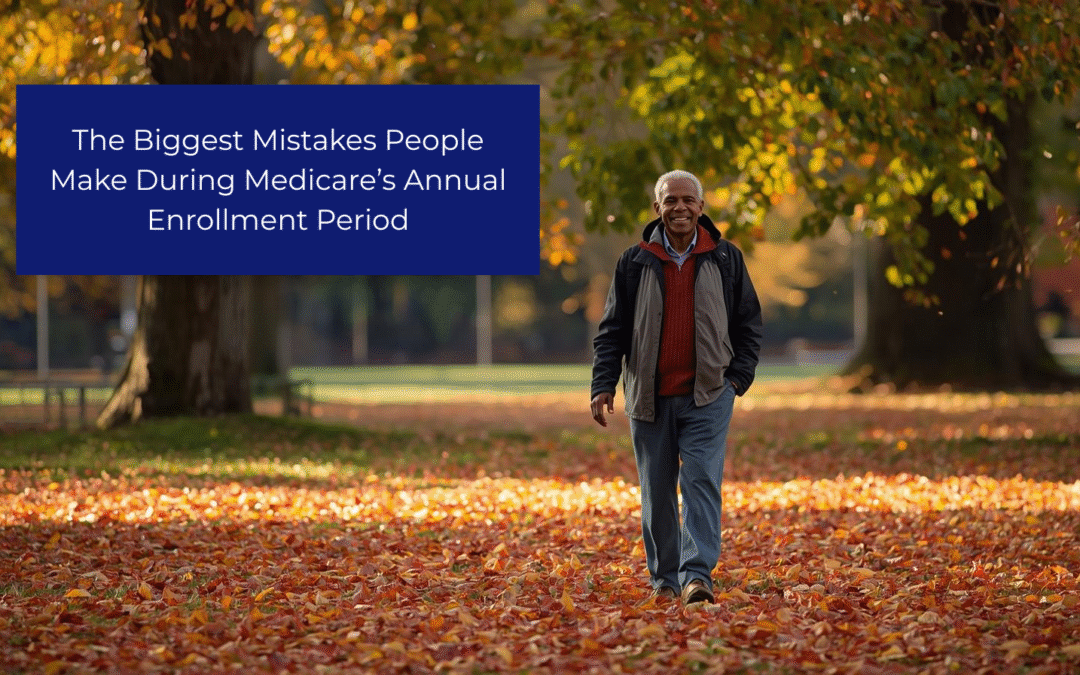Every Year, Millions of People Get This Wrong.
Let’s be honest — Medicare’s Annual Enrollment Period (AEP) can feel like a chore. The ads start flying, your mailbox fills up, and suddenly everyone’s talking about “reviewing your coverage.”
But here’s the thing: this window (October 15 – December 7) is one of the few chances you get each year to make real changes to your plan. And too many people miss it — or worse, make costly mistakes that haunt them all next year.
Let’s walk through the biggest ones I see, year after year.
Mistake #1: Assuming Your Current Plan Is Still the Best
This is the #1 trap people fall into — renewing without looking.
Carriers can (and do) change things every year:
-
Drug formularies (which drugs are covered and at what tier)
-
Doctor networks
-
Premiums, deductibles, and copays
-
Extra benefits like dental or vision coverage
Just because your plan worked well last year doesn’t mean it will next year. Always check your Annual Notice of Change (ANOC) — that’s where the fine print lives.
If you don’t, you might find out in January that your medication jumped tiers or your favorite doctor is suddenly “out of network.”
Mistake #2: Ignoring Prescription Drug Coverage Changes
Drug coverage is where the sneakiest costs hide.
Each year, plans reshuffle their formularies — drugs move to higher tiers, get dropped, or require prior authorizations.
If you take regular prescriptions, review your plan’s drug list for 2026. Even a single change can turn a $10 refill into a $100 surprise.
You can compare plans at Medicare.gov or use your pharmacy’s plan-finder tool.
Mistake #3: Waiting Until December to Act
Here’s what happens every December: people panic.
By the time you call for help, wait times are long, appointments are booked, and your patience is gone.
Even worse, many people make rushed choices without fully comparing plans — or they miss the deadline altogether.
If you start early (October or early November), you’ll have time to:
-
Review your current plan
-
Compare new options
-
Confirm your doctors and prescriptions
-
Ask questions before the December 7 rush
Don’t wait until the last minute. A calm decision beats a fast one every time.
Mistake #4: Only Looking at the Premium
Premiums are important — but they’re not the whole story.
A $0 or low-premium plan might sound great… until you hit the doctor’s office and see the copays, coinsurance, or drug costs.
Look at the total cost of care:
-
Premium
-
Deductible
-
Copays for your main services
-
Prescription costs
The best plan is the one that fits your real health needs and budget, not just the one with the lowest price tag.
Mistake #5: Forgetting to Check Provider Networks
Plans change networks all the time. That means your doctor, specialist, or hospital might not be covered next year — even under the same plan name.
Always double-check that your main providers are still in-network for the coming year. Otherwise, you could end up paying out-of-network rates or having to switch doctors midyear.
Mistake #6: Assuming “Doing Nothing” Is Safe
If you do nothing during AEP, your plan will likely auto-renew.
But that doesn’t mean it’s still right for you. You might:
-
Miss new benefits added elsewhere
-
Lose coverage for a drug
-
Face higher out-of-pocket costs
The bottom line: “auto-renew” is not a strategy. It’s a gamble.
Mistake #7: Not Asking for Help
You don’t have to figure this out alone.
Whether you talk to a licensed insurance agent, use Medicare’s Plan Finder, or call your State Health Insurance Assistance Program (SHIP), getting a second set of eyes can make a huge difference.
A 20-minute review can save you hundreds (or thousands) over the next year.
FAQs
Why do so many people make mistakes during AEP?
Because they assume their current plan is still fine and skip reviewing the details — even small changes can cause big cost surprises next year.
What’s the biggest mistake people make during Medicare’s Annual Enrollment Period?
The top mistake people make during the Annual Enrollment Period is not reviewing their plan’s 2026 changes, especially drug coverage and doctor networks.
Why should I review my drug coverage every year?
Because formularies change annually — a medication that was affordable last year might jump tiers or drop off the plan completely.
What’s the easiest way to avoid all these AEP pitfalls?
Start early, review your plan carefully, confirm your doctors and drugs, and don’t assume last year’s plan is still the best fit.
How to Avoid These Mistakes
The Annual Enrollment Period is your once-a-year chance to make sure your coverage still fits your life.
Don’t let procrastination, assumptions, or small print trip you up. Start early, ask questions, and double-check everything.
You’ll thank yourself in January.




